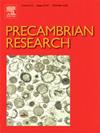Depositional age and environment of the Xinyu iron deposit in the Nanhua Basin, South China
IF 3.2
2区 地球科学
Q2 GEOSCIENCES, MULTIDISCIPLINARY
引用次数: 0
Abstract
Deposition of Neoproterozoic iron formations (IFs) was typically associated with Cryogenian glaciations and the breakup of the Rodinia supercontinent. Neoproterozoic IFs in South China are distinct, however, as they lack evidence for glacial and volcanic influence. The correlation of these IFs with Neoproterozoic sedimentary successions and their depositional environment remain controversial. Here we present new geochronological and geochemical constraints on the depositional age and environment of the Xinyu IF, one of the largest Neoproterozoic IFs in the Nanhua Basin of South China. The Xinyu IF, intercalated with clastic rocks and not in direct contact with glaciogenic sedimentary rocks, suggests deposition in an open water environment during the Sturtian glacial period. The Xiafang Formation, which hosts the Xinyu IF, overlies the diamictite-bearing Gujia Formation and underlies the gravel-containing and manganese (Mn)-bearing of the Dashajiang Formation. The youngest three zircon grains of the Xiafang Formation give a weighted mean 206Pb/238U age of 694 ± 17 Ma, representing the maximum depositional age of this formation. The Xiafang Formation is, therefore, likely correlated to the Liangjiehe Member of the Fulu Formation in the western Nanhua Basin, and was likely deposited between 694 ± 17 and 691 ± 12 Ma. Shale-normalized rare earth element (REE) plus Y (REY) patterns of the Xinyu IF samples display light REE depletion (average (LREE/HREE)SN = 0.37) relative to heavy REE, insignificant Eu anomalies (Eu* = 0.85−1.21), and no Ce anomalies (Ce* = 0.95−1.00). These geochemical characteristics suggest that the Xinyu IF was likely deposited in anoxic seawater in which Fe(II) was likely sourced from low-temperature hydrothermal fluids. Collectively, we suggest that the Xinyu IF is a Cryogenian IF deposited in open water during the Sturtian glaciation.
华南华南盆地新余铁矿床沉积时代与沉积环境
新元古代铁地层的沉积通常与冰川期的冰川作用和罗丁尼亚超大陆的分裂有关。然而,由于缺乏冰川和火山影响的证据,中国南方新元古代的IFs是不同的。这些IFs与新元古代沉积序列及其沉积环境的对比仍存在争议。本文对华南华南盆地新元古代最大的新元古代IF之一新余IF的沉积时代和环境进行了新的年代学和地球化学约束。新余IF夹层为碎屑岩,与冰期沉积岩没有直接接触,表明其沉积于斯图特冰期的开阔水域环境。下坊组赋存新余IF,位于含二晶岩的古家组之上,位于含砾石和含锰的大沙江组之下。下坊组最年轻的3颗锆石年龄加权平均为206Pb/238U年龄(694±17 Ma),代表下坊组最大沉积年龄。下坊组与华南盆地西部富鲁组良街河段可能形成于694±17 ~ 691±12 Ma之间。新余IF样品页岩标准化稀土元素(REE) + Y (REY)模式显示稀土元素相对于重稀土元素的轻亏损(平均(LREE/HREE)SN = 0.37), Eu异常不显著(Eu* = 0.85 ~ 1.21), Ce无异常(Ce* = 0.95 ~ 1.00)。这些地球化学特征表明新余IF可能沉积于缺氧海水中,其中Fe(II)可能来源于低温热液。综上所述,我们认为新余中频是一个在斯图特冰期沉积于开阔水域的低温期中频。
本文章由计算机程序翻译,如有差异,请以英文原文为准。
求助全文
约1分钟内获得全文
求助全文
来源期刊

Precambrian Research
地学-地球科学综合
CiteScore
7.20
自引率
28.90%
发文量
325
审稿时长
12 months
期刊介绍:
Precambrian Research publishes studies on all aspects of the early stages of the composition, structure and evolution of the Earth and its planetary neighbours. With a focus on process-oriented and comparative studies, it covers, but is not restricted to, subjects such as:
(1) Chemical, biological, biochemical and cosmochemical evolution; the origin of life; the evolution of the oceans and atmosphere; the early fossil record; palaeobiology;
(2) Geochronology and isotope and elemental geochemistry;
(3) Precambrian mineral deposits;
(4) Geophysical aspects of the early Earth and Precambrian terrains;
(5) Nature, formation and evolution of the Precambrian lithosphere and mantle including magmatic, depositional, metamorphic and tectonic processes.
In addition, the editors particularly welcome integrated process-oriented studies that involve a combination of the above fields and comparative studies that demonstrate the effect of Precambrian evolution on Phanerozoic earth system processes.
Regional and localised studies of Precambrian phenomena are considered appropriate only when the detail and quality allow illustration of a wider process, or when significant gaps in basic knowledge of a particular area can be filled.
 求助内容:
求助内容: 应助结果提醒方式:
应助结果提醒方式:


